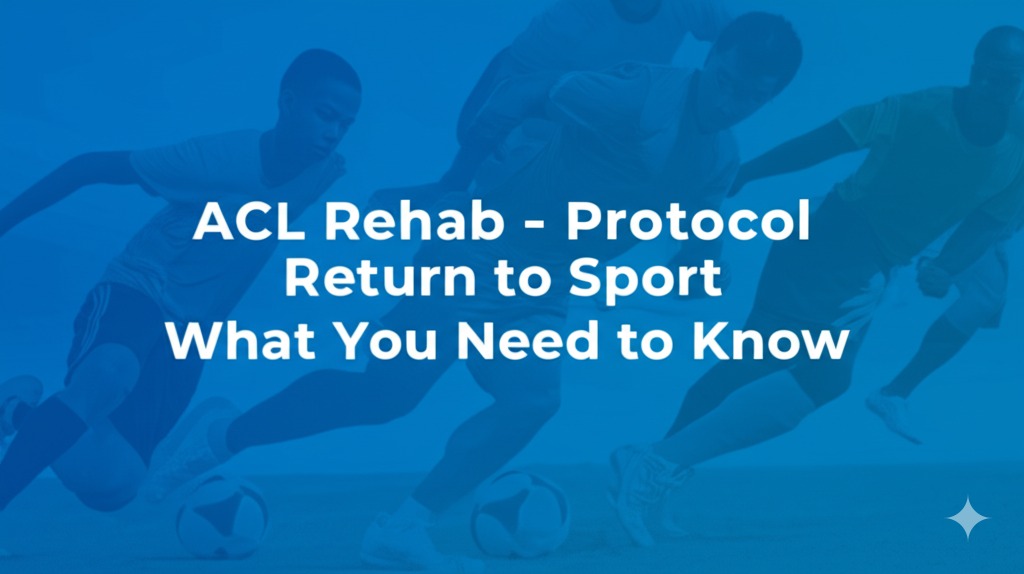An anterior cruciate ligament (ACL) injury can be a major setback for athletes and active individuals. Whether you’re a weekend warrior or a professional player, getting back to your sport safely and effectively requires a structured ACL rehab protocol. But when exactly is the right time to return? And how do you ensure you’re truly ready?
In this guide, we’ll break down the ACL rehab process, explore the critical milestones for returning to sport, and highlight how to reduce the risk of re-injury.
What Is ACL Rehab and Why Is It So Important?
The ACL plays a crucial role in stabilizing the knee, especially during movements like pivoting, jumping, and sudden stops. After an ACL tear—whether treated surgically or non-surgically—the knee needs time and structured rehab to regain strength, control, and stability.
Rehabilitation after an ACL injury is not just about healing—it’s about preparing the body to handle high-level athletic demands. Skipping steps or rushing the process can significantly increase the risk of re-injury.
Key Phases of ACL Rehab Protocol
An effective ACL rehab protocol typically unfolds in structured phases. Each phase has specific goals and criteria to progress to the next.
Phase 1: Prehabilitation (Pre-Surgery or Early Post-Injury)
- Goals:
- Reduce swelling and inflammation
- Restore knee range of motion (ROM)
- Begin gentle strengthening
- Activities:
- Isometric quad sets
- Heel slides
- Straight-leg raises
This phase prepares the knee for surgery or lays the groundwork for conservative treatment.
Phase 2: Early Post-Operative Phase (Weeks 1–4)
- Goals:
- Protect the graft (if surgery was performed)
- Regain full extension and controlled flexion
- Activate the quadriceps
- Activities:
- Stationary biking with low resistance
- Closed-chain strengthening (e.g., mini squats)
- Gait training
Phase 3: Strengthening and Control (Weeks 4–12)
- Goals:
- Increase strength and endurance
- Improve neuromuscular control
- Activities:
- Single-leg exercises
- Step-ups, lunges
- Balance and proprioception work
Phase 4: Advanced Strengthening and Sport-Specific Drills (3–6 Months)
- Goals:
- Return to pre-injury strength
- Begin agility and sport-specific movements
- Activities:
- Plyometrics (jump training)
- Lateral shuffles and cone drills
- Controlled pivoting and deceleration
Phase 5: Return to Sport (6–12+ Months)
- Goals:
- Demonstrate full strength, stability, and confidence
- Pass return-to-sport testing
- Activities:
- Simulated game drills
- High-speed cutting and jumping
- Functional performance assessments
Return-to-Sport Criteria: Are You Truly Ready?
Returning to sport isn’t about hitting a calendar date—it’s about meeting specific objective criteria. These include:
- 90%+ strength compared to the uninjured leg
- Functional hop tests (e.g., single-leg hop, triple hop)
- Good movement mechanics during jumping, landing, and cutting
- Minimal swelling or pain after advanced training
- Psychological readiness and confidence in the knee
Failing to meet these standards can double the risk of a second ACL injury, especially in younger athletes.
Common Mistakes in ACL Rehab
Avoid these pitfalls to ensure a safe return to sport:
- Skipping rehab sessions or undertraining
- Returning too early based on time alone
- Ignoring asymmetries between legs
- Neglecting mental recovery (confidence and fear of re-injury matter!)
Working with a licensed physical therapist who specializes in sports rehab is crucial for proper progression and injury prevention.
Psychological Readiness: The Missing Link in ACL Recovery
A surprising but essential piece of the puzzle is the mental aspect of recovery. Many athletes report fear, hesitation, or lack of confidence even when physically cleared.
Strategies to support mental recovery include:
- Sports psychology counseling
- Visualization techniques
- Gradual exposure to sport-specific movements
Confidence is key—without it, even a strong knee may not perform at its best.
Final Thoughts: Patience Pays Off
The journey from an ACL injury back to sport is long—but it’s also incredibly rewarding. Following a comprehensive ACL rehab protocol ensures your knee is not just healed, but strong, stable, and ready to perform.
Take your time, trust the process, and prioritize quality rehab over quick fixes.

Kallie Snyder is an author at Stonegate Health Rehab, providing valuable insights, recovery guidance, and rehab resources to help individuals achieve better health and well-being.
